How to pack away your camping gear for winter
The end of the camping season is always a sad moment and you’ll need to make sure your gear stays in top condition during its hibernation
As most of us prefer to camp in milder weather with longer hours of daylight, keeping your tent and camping gear in good repair when it’s stored away for some time over winter is important.
Tempting as it might be to throw it all in the garage or shed and forget about it until spring, there are some essentials you need to do to make sure you don’t get any nasty surprises when you get ready for the first trip of the year.
You should also carry out some of these jobs after every camping trip to ensure your gear remains in good condition.
Page contents
- At the campsite
- When you get home
- Clean the rest of your gear
- Camping gear storage
- Final thoughts
- About our magazine
Words by Iain Duff
At the campsite
Packing away your tent after camping
Your efforts to take care of your tent should start before you even leave the campsite.
Before taking your tent down, give it a wipe and clean off the worst of any dirt that might have accumulated during your stay, especially bird droppings or tree sap. Try to wipe the worst of the mud off tent pegs as you pull them out of the ground, too.
Ideally, you should try to take your tent down when it is dry. No matter how dry and sunny it’s been during your stay, you can be certain that on the morning before you’re due to pack up and go the sky will darken and the heavens will open.
Not only does that mean you have to take down your tent and pack away your gear in the rain, but you also have to work out how to dry your tent.
Shake off as much water as possible and wipe more off with a clean, dry cloth or a towel. If the tent is still damp and you have room in the car, drape it loosely over the luggage in the boot rather than putting it into the bag.
Packing away your gear after camping
A mini dustpan and brush set is really useful for sweeping up before packing away your tent. Remember to empty out the storage pockets.
Empty and, if necessary, take down and pack away the inner tents before clearing the tent.
Keep a few plastic bags to hand for packing away wet, muddy items. Pack dirty clothes in a separate holdall so the washing machine can be loaded as soon as you get home. If the weather is fine, leave sleeping bags out to air before packing them away.
Packing up can be a wet and muddy experience – so get changed into clean clothes before you drive home.
When you get home
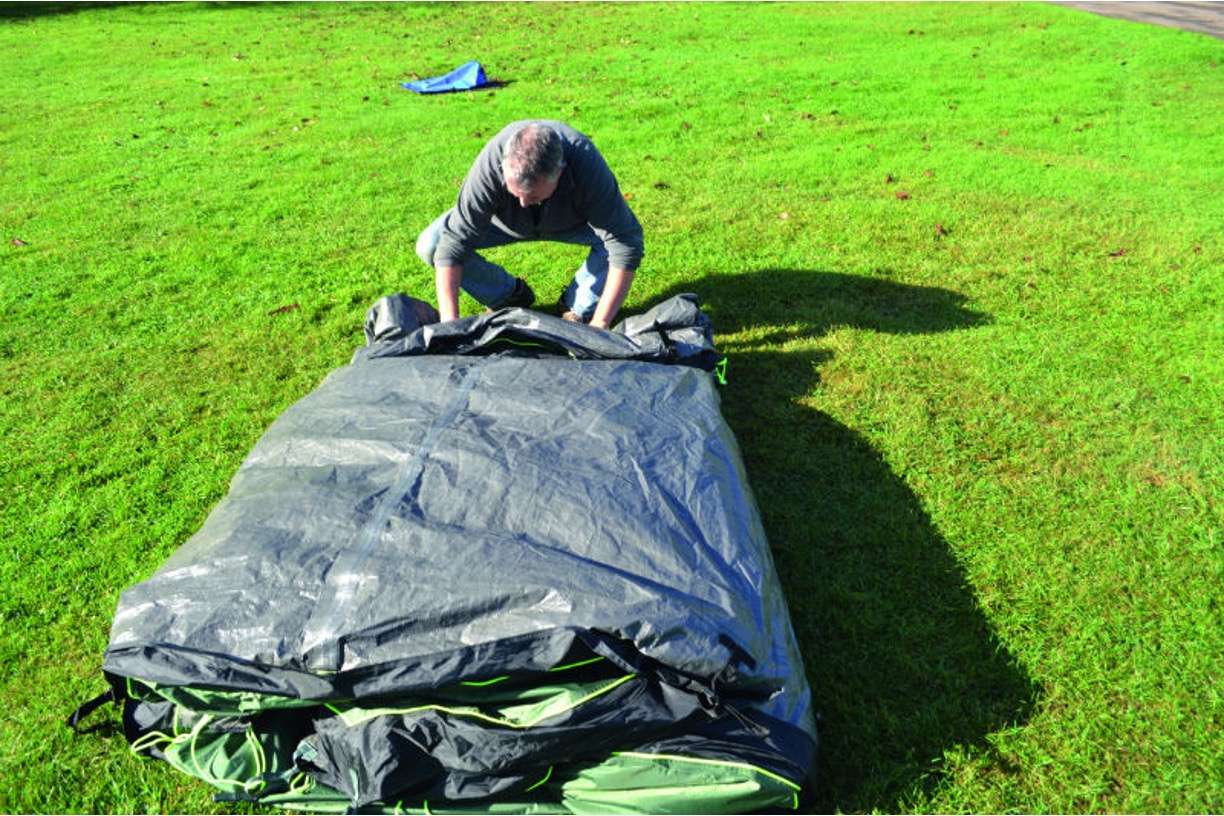
(Photo by Iain Duff)
Dry your tent
Whether it's polyester, polycotton or traditional canvas, if you pack a tent away into a bag when it is still damp, it could cause irreparable damage.
The biggest issue you’ll face is mould and mildew, which will make the tent smell bad and eventually can cause the fabric to rot away, leaving it only fit for the bin.
For the best way to dry a tent after camping, when you get home from your camping trip, unpack the tent straight away and leave it out to dry. Even leaving it in the bag for a few days can cause irreparable damage.
If the tent is completely clean, you can set about drying it. If the weather allows and you have the space, peg the wet tent out in your garden for a few hours, until all the water has evaporated. Then take the tent down and pack it away immediately. If you don’t have a big enough garden, rather than pitching the tent, you could hang it over the washing line, the whirly or even the children’s trampoline.
If it’s still raining, you’ll have to think of another way. Assuming they are watertight themselves, your garage, garden shed or even a greenhouse could be good alternatives when it comes to drying wet tents. String a couple of washing lines across the inside and hang the tent over them, using clothes pegs to keep them in place if necessary.
Drying in the house is not ideal, but if you don’t have a garden or an outbuilding you can use, then it might be that you’ve got no alternative. Before bringing it indoors, wipe away as much excess water as you can to prevent any damage to carpets and furniture. A staircase with a banister is a good place to hang your tent out and, if it's folded out properly, the tent will be dry in no time, especially if you can put on the central heating.
As tempting as it might sound, putting your tent in the washing machine and putting on the spin cycle isn’t recommended. For a start, the weight of the tent could be too heavy for your machine and cause irreparable damage and, even if it doesn’t, the action of the spin could damage the tent. The heat of a tumble dryer will also cause damage to the tent, more than likely removing the waterproofing, and could even melt the fabric.
The reality is, there are no real shortcuts to getting your tent dry, you just need to let nature take its course. Be patient and wait until the tent is completely dry before you pack it away.
Clean your tent
If, when you get home, the tent is dirty then you should give it a good clean before storing it away. Mud, tree sap and bird droppings on the flysheet are among the biggest issues to deal with, while cooking stains and grubby hands can make a mess of the inner tent.
Here’s how to clean your tent after camping:
Start by spreading the flysheet out flat on the ground or, if you have the space, pitching it in your back garden. Brush off any loose dirt and clean the affected area with a sponge.
- Always use a proprietary tent cleaner, NEVER a detergent or washing-up liquid as these will strip off the waterproof finish.
- Cleaning and reproofing materials from brands like Storm, Nikwax, Grangers, Fabsil and Fenwick's can be found at most camping shops.
- Stubborn marks like tree sap, bird lime or fatty cooking stains are a real problem. Spray the affected area with stain remover to break down the acid and fats in these stains. Rub over the treated area with a sponge to help remove staining and then rinse thoroughly.
- Dusting tree sap with talc and then rubbing it off is often suggested as a way of dealing with the problem, but we’ve always found this has limited results. Another method is rubbing the resin with an oily substance, such as peanut butter or mayonnaise, but again we get better results from simply using a tent cleaner.
- Bird droppings are particularly unpleasant but are easily removed by brushing off if dry or gently washing away with a mild soap or a tent cleaner. Rinse well with clean water.
- The best approach to mildew is to prevent it forming in the first place by always packing away your tent dry (see above). But if mildew spores are present, they need to be treated quickly to prevent any further spread. Sponging down with a weak solution of a sterilising fluid such as Milton is best and will help reduce the musty aroma but it’s unlikely to remove the stain. Ensure that the treated area is allowed plenty of time to dry before packing away.
Check for any damage
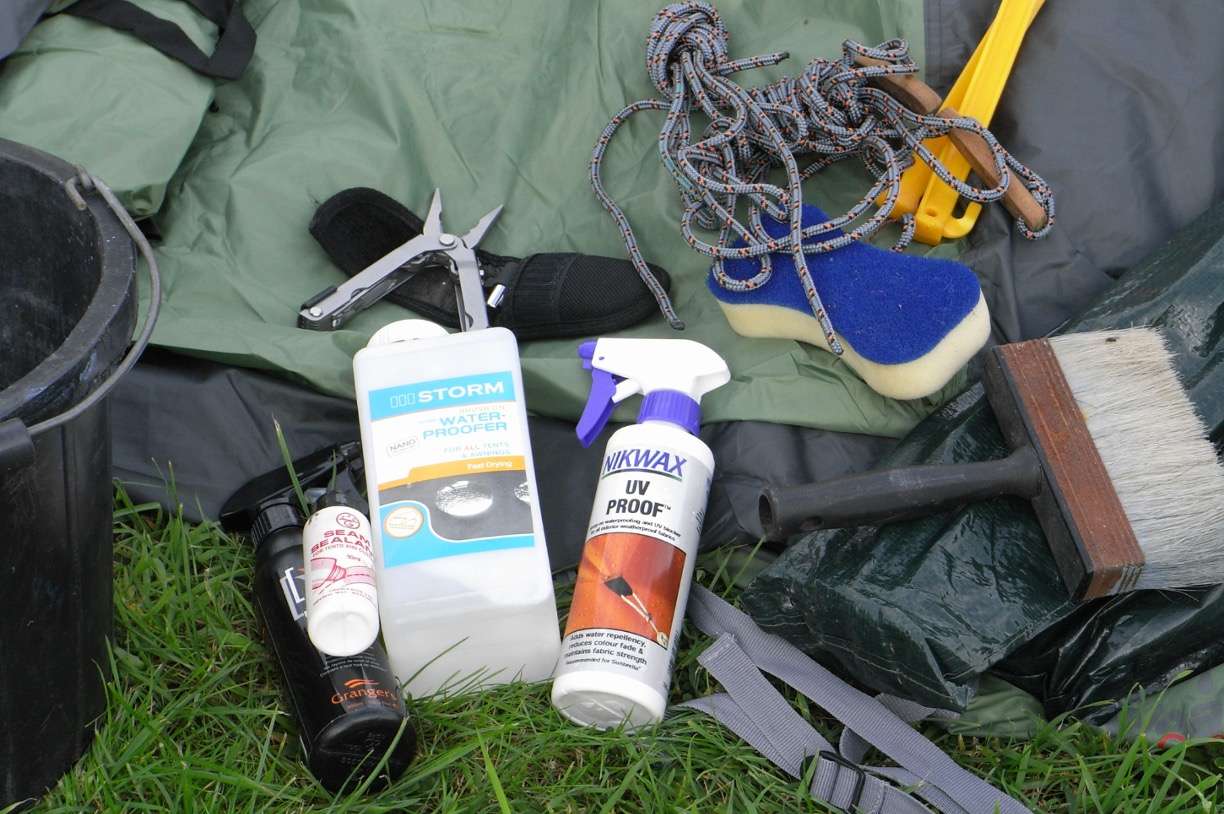
(Photo by Iain Duff)
Check carefully for holes, tears, seam strains or any other signs of wear. Those repair kits that came with the tent and airbeds may now come into their own. Even better, it is probably a slack time at camping shops so nip along and see what bargains are begging to be bought.
In particular, look out for and replace broken poles, damaged zips and worn guylines. Also check for tears in the groundsheet and flysheet. Some rips can be simply sewn back together, either by hand or with a sewing machine, then coated on both sides with seam sealant. For ragged tears and seams it makes sense to add a patch.
Glueing as well as sewing the patch on will make the repair more durable, and again, you should apply a seam sealant. Depending on the problem, sometimes simply taping up a hole or tear may well suffice for years and there’s no need to go overboard before storage.
Check the overall state of the outer fabric as, if the damage is down to age, use and the effects of bright sun, then a temporary fix might be a waste of time and a new tent is needed.
As inner tents are not designed to be waterproof, fabric can be stitched up fairly easily even when torn in a ragged pattern.
Sewn-in groundsheets can easily be damaged by stones on your pitch. A tear or hole can be fixed with a patch but if there is a lot of damage then it’s impossible to fix. The problem then is if you have a sewn-in groundsheet, your entire tent is rendered useless. The best way to avoid this is to use a groundsheet footprint from the start. This protects the groundsheet from any sharp objects on the pitch and is much easier to clean when you get home.
Reproof your tent
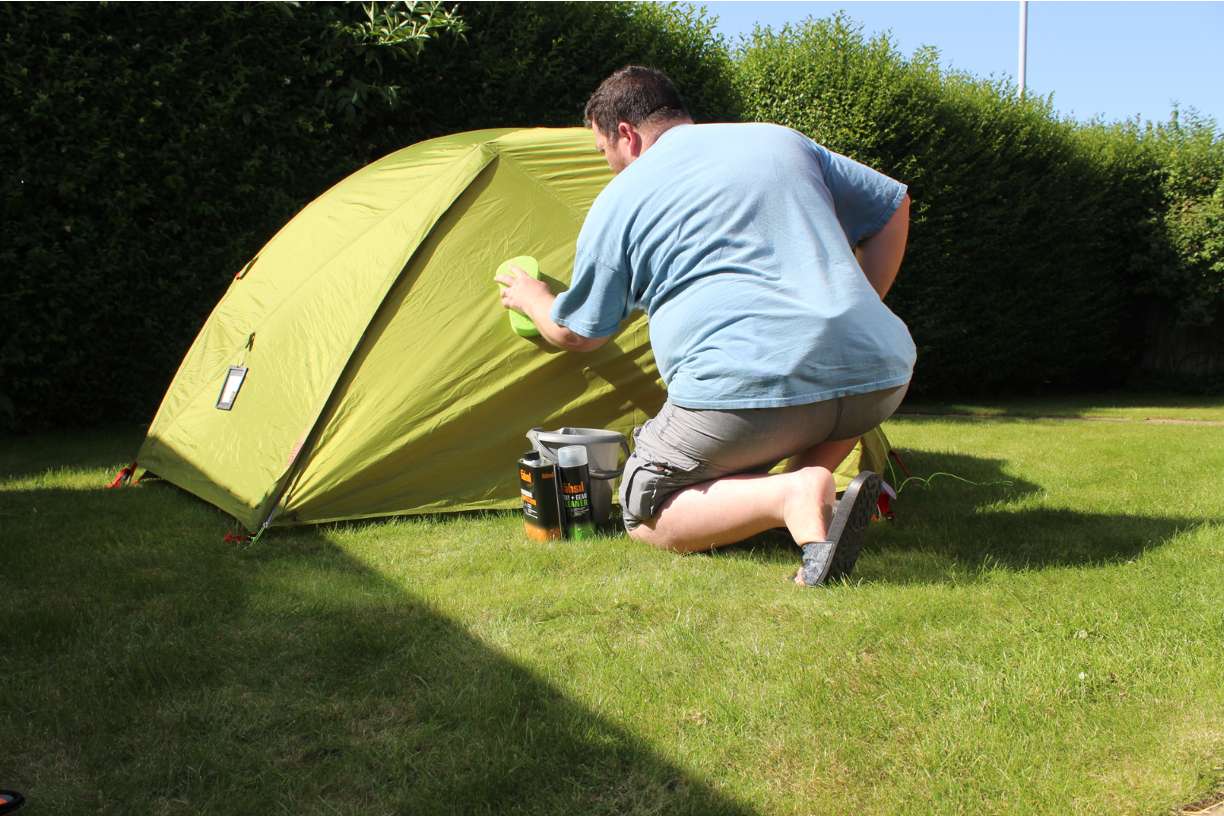
(Photo by Iain Duff)
You’ll know your tent needs waterproofing if the rain starts to darken the flysheet. Cleaning and reproofing materials from brands like Storm, Nikwax, Grangers and Fabsil can be found at most camping shops.
Thoroughly clean the tent fabric before applying the proofer. Large tents will have to be pitched and brush-washed by hand but smaller tents should fit into domestic washing machines.
There are two main types of proofer: water-based and solvent-based. Solvent products dry quicker – from just a few minutes for a fluoropolymer product such as Storm brush-on proofer to a couple of hours for a silicone product.
Spray-on applications are convenient and easy to use – especially on smaller tents. Treatments vary in application to wet or dry fabric – you’ll find advice and instructions on the container and on the manufacturers’ websites
Clean the rest of your gear
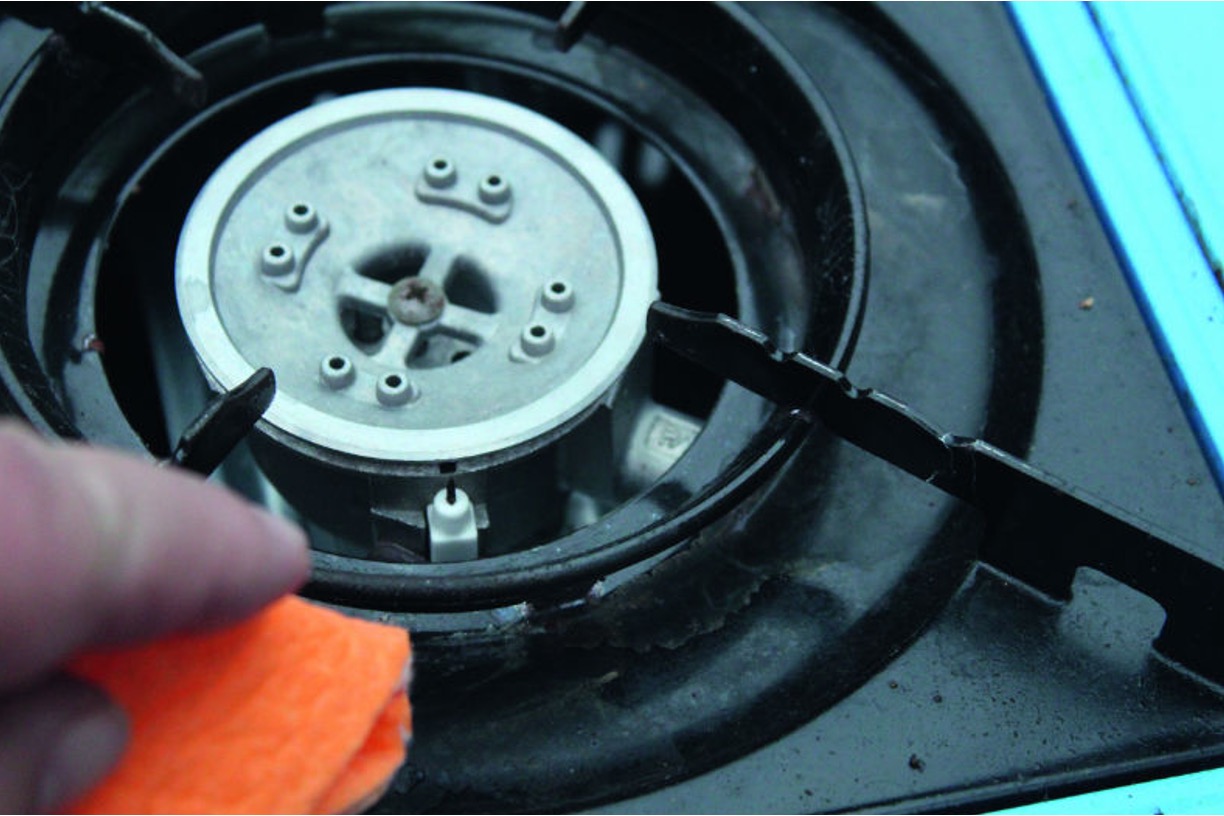
(Photo by Iain Duff)
When you get home from your camping trip, wipe down tent furniture like wardrobes, kitchens, tables and chairs and check for any damage. All sorts of crumbs plus other food stains and remains might fester through the winter so give fabric, shelves and structures a good wash.
Washing surfaces, fabrics and structures with a mild solution of bleach helps with hygiene and prevents the spread of mildew. Clean out coolboxes and food storage containers thoroughly.
Camping stoves can easily get dirty through general use and you should wipe down the outside regularly during camping trips to prevent a build-up of grime. Annual cleanings are recommended before storing your stove at the end of the camping season – give the burners a clean with warm, soapy water and a cloth.
If the gas jets get clogged, unscrew the burner from the stove, lift off the rings and use a small needle to clear any waste, then clean it with soap and warm water before rinsing and reassembling. Make sure it’s completely dry before packing away. Pots and pans will also benefit from a good scrub, as well as the stove storage bag.
Proper care is essential to prolong the life of your sleeping bag. They probably won’t need to be cleaned after every trip, but definitely give them a wash at the end of the season. Find out how to clean synthetic-filled and down-filled sleeping bags here.
Camping gear storage
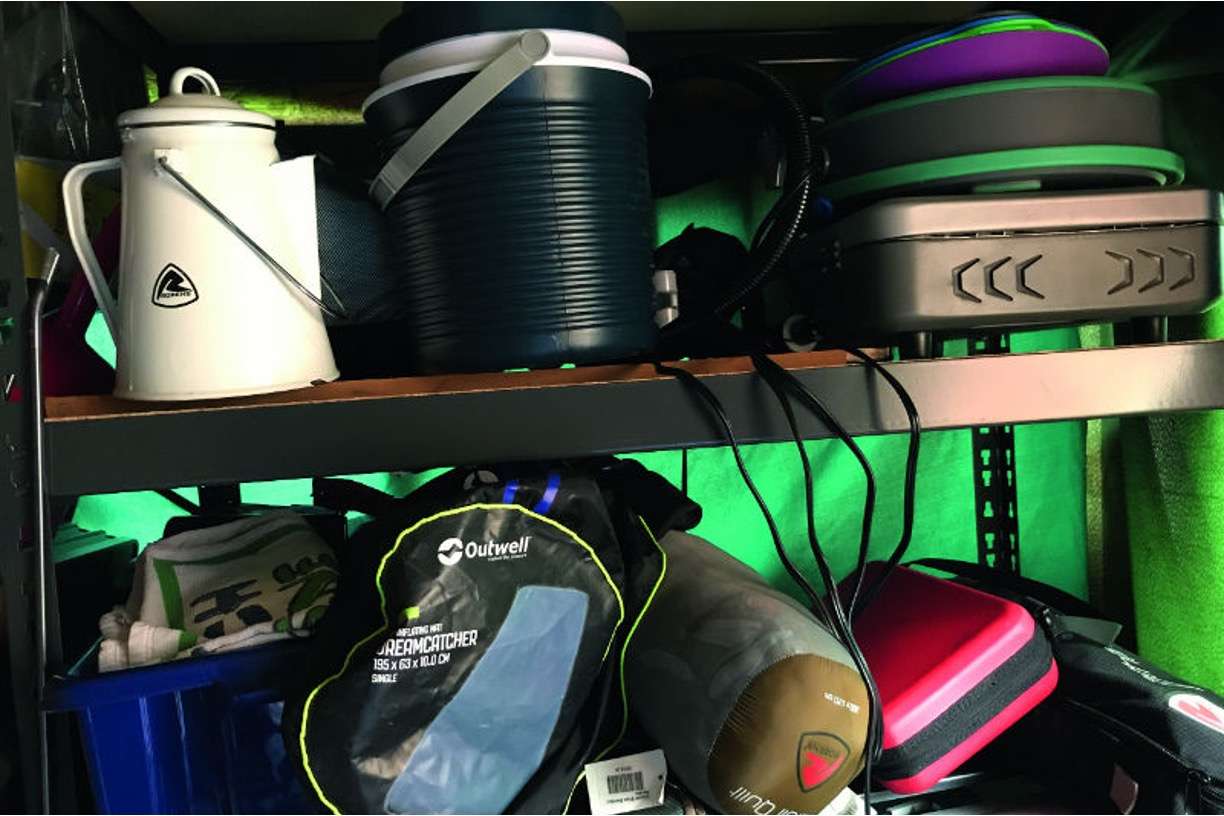
(Photo by Iain Duff)
Make a to-do list for your camping gear and tent storage and check it off as you go along, looking out for anything that is missing, broken or damaged:
- Pack the tent loosely and store it somewhere dry and cool, like a loft, garage or shed, and out of direct sunlight.
- Storing gear high up can help keep it away from rodents, but remember tents can be very heavy, so be careful not to put it somewhere that it could fall on you!
- For long-term storage, put sleeping bags in large mesh bags or folded neatly in a wardrobe or airing cupboard, rather than compressing them into their stuff bags. This will ensure the filling retains its loft and will perform better the next time you use it. Take a close look at drawcords, zips and seams, repairing damage where you can.
- Remove the batteries from any gadgets and lanterns and store them separately. This will stop the batteries running out and will avoid the danger of corrosion damage.
- Food smells attract animals and they will cause irreparable damage to gear by chewing through it on the hunt for something tasty to eat. Make sure you air out or wash all gear that smells of food and sweep out any crumbs before packing.
- One of the most often overlooked items that needs a regular overhaul is the first aid kit. Check the dates and condition of creams, salves, drops, tablets and so on, binning and replacing as required.
- Pegs may be straightened or replaced as appropriate to avoid rediscovering problems on the first trip next year.
Storage checklist
- Wipe down furniture
- Clean camping cookers
- Wash out coolboxes
- Empty food containers
- Air sleeping bags
- Replace damaged pegs
- Check your first aid kit
- Pack tents loosely
Final thoughts
Properly storing your camping gear is crucial for its longevity. Take the time to follow these steps and your equipment will be ready for the next camping season.
Ensure a smooth start to your next adventure by investing time in post-camping care and storage.
Expert Camping advice!

Camping magazine has been the voice of campers for over 60 years!
Camping is the UK's only magazine devoted to the wonderful world of life under canvas and the freedom it brings.
Every issue is packed with inspirational travel, the top camping sites to stay on, reviews of the latest tents, camping gear reviews, practical help and much more to help you get the most out of your camping adventures.
Want to know more about Camping magazine?
About Camping magazine







Recent Updates
Our family camping checklist: everything you need to pack
Sure, you’ve packed the tent and the sleeping bags – but what about slip-on shoes and glow sticks? These are the family camping essentials that you ...
Our guide to planning the perfect camping road trip
Roll down the window, pop on those shades and crank up the volume – it’s time for a road trip. Get ready for ...
Camping in Europe: our 12 top tips
If you’ve not camped in Europe before, there’s a few tips and tricks you’ll need to avoid some continental ...
Solar power for camping: all you need to know
Staying connected in the great outdoors is easier than ever with a solar charger – or is it? How reliable are ...
Wild camping kit list: everything you need for your next adventure
Make sure you’re ready for anything with this list of lightweight camping gear and clothing, including ...
Camping furniture: all you need to know to make your tent a cosy haven
We delve into the essentials of camping chairs, camping tables, and kitchen and bedroom furniture, ensuring ...
Camping lights for tents: What you need to know
We will guide you through all the lighting options available for you and your tent, including interior ...
Camping kitchen: all you need to know
In the great outdoors, a well-equipped camping kitchen transforms mealtime into a delightful adventure ...
Camping guide to trailers
Trailer stash or trailer trash? Being able to carry lots of other gear when you go camping isn’t such a bad ...
Winter camping: all you need to know to keep warm
Winter doesn’t have to mean the end of the camping season. With good preparation and the right gear, there’s ...
Other Articles
Camping toilets: a complete guide
If you are wild camping, camping off-grid or the campsite you book onto doesn’t have toilet facilities, you will need to consider alternative ...
Top tips for camping in windy weather
How to make sure your tent stands up to gusty conditions ...
Camping tents: a complete guide
If you're considering buying a camping tent, whether it's your first time or you're a seasoned camper, making ...
Camping sleeping bags and beds: a complete guide
When it comes to camping, there's one essential item that can make or break your outdoor adventure: the ...
Camping gas: how to use gas on the campsite
A complete guide to using camping gas appliances safely on the campsite, from choosing the right stove to ...
Camping storage: a complete guide
Having problems knowing where to put all your gear when you're camping? Read our top tips and see some great ...
Camping electric hook-up: a complete guide
This is everything you need to know about using electricity on a campsite, including how to hook up ...
How to pack all your camping gear into your car
Planning a family camping holiday? Find out the best way to fit all the kit you need into your car boot, roof ...
Camping stoves and cookers: the complete guide
Camping stoves are an essential part of any outdoor adventure, allowing you to prepare meals and hot drinks ...
How much does camping cost?
At a time when everyone’s budgets are being squeezed, camping holidays offer great value for money. Shop ...